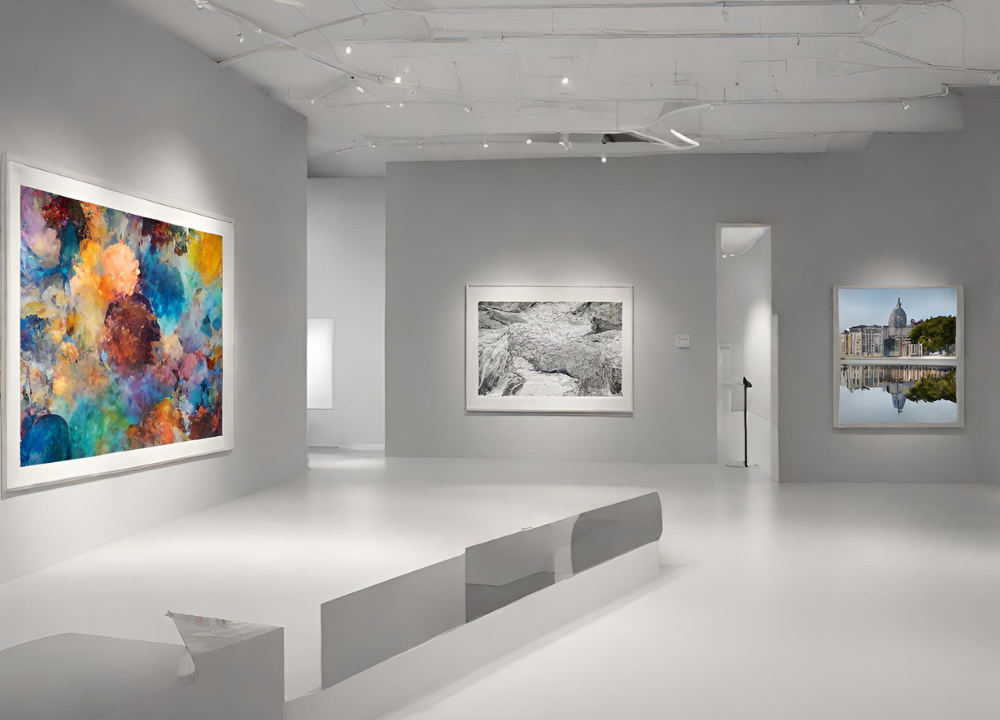Decoding Virtual Exhibitions: Unraveling the Differences in Artistic Realms is an article that aims to provide a concise understanding of the variations between different artistic realms in the context of virtual exhibitions. With virtual exhibitions gaining popularity, it has become crucial to grasp the distinctions between these realms.
By examining key factors such as audience engagement, artistic representation, and interactive features, one can decode and comprehend the unique aspects of each realm. Let’s dive into the depths of virtual exhibitions and explore the intricacies of art in the digital world.
The Rise Of Virtual Exhibitions
Virtual exhibitions have revolutionized the way we experience and appreciate art, bringing the artistic realms to our fingertips. These digital platforms have opened up a whole new world of possibilities and opportunities for artists and art enthusiasts alike. In this article, we will explore the evolution of artistic representation and the growing popularity of virtual exhibitions.
Evolution Of Artistic Representation
Artistic representation has come a long way over the centuries. From cave paintings to Renaissance masterpieces, artists have continually pushed boundaries to embrace new mediums and techniques. In recent years, technology has played a pivotal role in shaping artistic expression, giving rise to virtual exhibitions.
With the advent of digital tools and software, artists can now create immersive and interactive experiences that defy the limitations of traditional art forms. Through virtual exhibitions, they can transcend physical barriers and transport viewers to imaginative realms, blending various elements like sound, animation, and interactivity. This evolution in artistic representation has opened doors to new possibilities and expanded the horizons of creativity.
The Growing Popularity Of Virtual Exhibitions
The demand for virtual exhibitions has been on the rise, fueled by advancements in technology and the changing dynamics of the art world. Here are some key factors that contribute to their growing popularity:
- Accessibility: Virtual exhibitions break down barriers of physical location, allowing individuals from around the world to access and engage with artwork. Regardless of their geographic limitations, art enthusiasts can explore vibrant collections and connect with artists in real-time.
- Convenience: In our fast-paced digital age, virtual exhibitions offer the convenience of experiencing art at our own pace and schedule. With just a few clicks, we can embark on a visual journey, navigating through the galleries and absorbing the beauty of art from the comfort of our homes.
- Interactivity: Unlike static displays, virtual exhibitions offer innovative ways to engage with art. Visitors can zoom in to examine intricate details or click on specific artworks to learn more about their inspiration and techniques. Some platforms even facilitate direct interactions with artists, enhancing the overall experience.
- Reach: Virtual exhibitions have the potential to reach a larger and more diverse audience compared to traditional brick-and-mortar galleries. Through social media and online promotions, artists can showcase their work to a global audience, fostering greater exposure and recognition.
The growing popularity of virtual exhibitions signifies a shift in the art world, embracing technology as a powerful tool for artistic expression and appreciation. As more artists and art enthusiasts embrace this digital realm, the future of art exhibitions continues to evolve and expand in exciting ways.

Exploring The Unique Features Of Virtual Exhibitions
Virtual exhibitions have revolutionized the way we experience and engage with art. They bring together the convergence of art and technology, creating a whole new realm for artists and viewers alike. Let’s dive deeper into the various aspects that make virtual exhibitions a unique and captivating experience.
Immersive Digital Environments
One of the standout features of virtual exhibitions is their ability to create immersive digital environments. Through advanced technology, artists can transport viewers into virtual worlds, where they can explore art in ways never before imagined. These environments can mimic physical gallery spaces or break free from traditional constraints, giving artists the freedom to experiment with unique settings and atmospheres. Whether it’s a serene museum-like setting or a fantastical world of imagination, virtual exhibitions offer endless possibilities for creating immersive experiences that captivate the senses.
Interactive Artistic Experiences
Virtual exhibitions take interactivity to a whole new level, allowing viewers to actively engage with the artwork. Beyond mere observation, virtual exhibitions enable visitors to interact with the art, often providing a more intimate and personalized experience. From virtual walkthroughs where viewers can navigate through the exhibition space to interactive installations that respond to viewer inputs, these features provide an active involvement that breaks the barriers between the artist and the audience. Interactive elements can include anything from clickable artworks for closer inspection to virtual reality experiences that allow viewers to step into the art itself. The possibilities for interaction are limited only by the artist’s imagination.
Accessible Global Audience
Unlike traditional physical exhibitions, virtual exhibitions have the advantage of reaching a global audience. With just an internet connection, art enthusiasts from all corners of the world can access and enjoy these exhibitions. Virtual exhibitions enable artists to showcase their work to a much larger and more diverse audience than ever before. This accessibility breaks down geographical barriers and opens up opportunities for artists to gain international recognition and connect with viewers who may not have had the chance to experience their art otherwise.
Challenges Faced In Virtual Exhibition Creation
Creating virtual exhibitions brings together different artistic realms and challenges. Overcoming these hurdles is crucial to delivering an immersive and captivating experience for visitors. Two key challenges faced in the creation process include technical constraints and possibilities, as well as striking the right balance between realism and artistic vision.
Technical Constraints And Possibilities
When it comes to virtual exhibition creation, understanding the technical constraints and possibilities is essential. Artists and curators need to navigate the limitations of the digital medium while capitalizing on its unique capabilities.
Some common technical constraints faced in virtual exhibition creation are:
- Limited interaction options that may hinder the viewer’s engagement with the artwork.
- Bandwidth and loading time limitations, impacting the smoothness of the virtual experience.
- The need for compatible devices and software, ensuring the exhibition is accessible to a wider audience.
On the other hand, virtual exhibitions also offer exciting possibilities:
- The ability to showcase artwork in a dynamic and interactive manner, enhancing the viewer’s immersion.
- Virtual reality (VR) technology that allows visitors to explore artworks in a three-dimensional space.
- Integrating multimedia elements such as videos, audio, and animations, adding a new layer of depth and storytelling.
Understanding these technical constraints and possibilities helps artists and curators make informed decisions throughout the virtual exhibition creation process.

Balancing Realism And Artistic Vision
Another crucial challenge in virtual exhibition creation revolves around striking the right balance between realism and artistic vision. While realism can enhance the viewer’s sense of immersion, maintaining the integrity of the artist’s vision is equally important.
Artists and curators must grapple with questions like:
- How realistic should the virtual environment be to create an authentic and believable experience?
- Does the virtual exhibition align with the artist’s intended presentation and aesthetic?
- How can the digital medium bring out the unique aspects of the artwork while staying true to the artist’s vision?
By finding the delicate equilibrium between realism and artistic vision, virtual exhibitions can captivate audiences while honoring the essence of the artwork.
Bridging The Gap Between Physical And Virtual Art Experiences
In the ever-evolving world of art, virtual exhibitions have emerged as a groundbreaking way to showcase and appreciate artistic works. With the advancement of technology, the line between physical and virtual art experiences has started to blur. Artists and art enthusiasts alike are embracing this new realm, driven by the desire to explore innovative ways of expressing creativity. To truly understand the differences between physical and virtual art, let’s delve into the distinctive elements that make each experience unique and captivating.
Integrating Traditional Art Elements
When it comes to virtual exhibitions, we witness a seamless integration of traditional art elements that have been a part of the art world for centuries. The virtual realm allows artists to incorporate familiar artistic techniques such as painting, sculpture, and photography into their digital creations. Through careful use of color, texture, and composition, artists can evoke the same emotional impact as they would with physical artwork. The ability to create multi-layered and immersive digital environments further enhances the viewer’s engagement, offering a fresh perspective on traditional art forms.
Incorporating Virtual Reality And Augmented Reality
In addition to seamlessly integrating traditional art elements, virtual exhibitions bring forth the exciting possibilities of virtual reality (VR) and augmented reality (AR). VR allows viewers to step into an entirely computer-generated environment, with the ability to interact and navigate through the art space. By wearing VR headsets, visitors can explore virtual galleries, examine artwork up close, and even experience virtual walkthroughs led by curators or artists themselves. On the other hand, AR enhances physical art experiences by overlaying digital elements onto the real world. With the help of smartphones or tablets, viewers can witness artworks come to life, revealing hidden layers of information or adding dynamic visuals for an enriched sensory experience.
The Impact Of Virtual Exhibitions On The Art World
Virtual exhibitions have brought about a transformative shift in the art world, revolutionizing the way artistic realms are accessed, consumed, and understood. With the advancement of technology, the impact of virtual exhibitions has been far-reaching, extending beyond physical limitations and traditional constraints. Let’s explore the key ways in which virtual exhibitions have influenced the art world.
Expanding Artistic Reach And Accessibility
The advent of virtual exhibitions has significantly expanded the artistic reach, breaking down geographical barriers and opening up endless possibilities for artists and art enthusiasts alike. No longer confined to a specific physical location, artists can showcase their work to a global audience and connect with individuals from all corners of the world. Likewise, art enthusiasts can explore diverse art forms and styles without the limitations of time and travel, making art more accessible and inclusive than ever before.
Revolutionizing Art Consumption And Education
Virtual exhibitions have revolutionized the way art is consumed and experienced, transforming art appreciation into a dynamic and immersive process. Through interactive platforms, viewers can engage with artworks on a deeper level, zooming in to capture intricate details, or rotating sculptures to view them from different angles. This innovative approach to art consumption allows for a more enriching and personal experience, enhancing the viewer’s understanding and connection with the artwork.
Beyond consumption, virtual exhibitions have also played a pivotal role in art education, providing a valuable resource for students, researchers, and educators. With the click of a button, individuals can access an extensive collection of artworks, historical references, and contextual information, expanding their knowledge and deepening their understanding of artistic movements and cultural significance. This digital platform has transformed the traditional learning experience, making art education more engaging, interactive, and comprehensive.
As virtual exhibitions continue to evolve and push the boundaries of artistic realms, their impact on the art world is undeniable. By expanding artistic reach and accessibility, as well as revolutionizing art consumption and education, these virtual platforms have reshaped the way we engage with art, fostering a more connected and inclusive art community. Whether you are an artist, enthusiast, or educator, virtual exhibitions have become an invaluable tool in unraveling the differences in artistic realms.
The Future Of Virtual Exhibitions
As technology continues to advance, the future of virtual exhibitions looks promising. Innovations in technology and advancements in user experience and interaction are revolutionizing the way we experience art in the virtual realm. This article explores these key areas in-depth.
Innovations In Technology And Artistic Expression
Advancements in technology have opened up a myriad of opportunities for artists to push the boundaries of their creativity in virtual exhibitions. With the introduction of virtual reality (VR) and augmented reality (AR), artists can now conceptualize and showcase their artwork in immersive and interactive ways.
- New tools and software empower artists to create dynamic and interactive digital art forms.
- VR allows visitors to virtually walk through art exhibitions from the comfort of their own homes.
- AR overlays digital elements onto the real world, enhancing the overall experience and blurring the line between reality and imagination.
Advancements In User Experience And Interaction
User experience (UX) and interaction play a crucial role in the success of virtual exhibitions. The goal is to create an experience that is both visually captivating and user-friendly. Artists and developers are constantly exploring new ways to engage visitors through intuitive interfaces and seamless interactions.
| Advancements in User Experience | Advancements in Interaction |
|---|---|
|
|
These advancements in UX and interaction ensure that virtual exhibitions provide a seamless and enjoyable experience for art enthusiasts, allowing them to fully immerse themselves in the digital art world.
Conclusion
As we dive into the realm of virtual exhibitions, we uncover a dynamic interplay between art and technology. The accessibility and immersive experience offered by virtual exhibitions redefine the traditional art world, opening up exciting opportunities for both artists and audiences.
Virtual exhibitions bridge geographical gaps, inviting individuals from around the world to engage with art in new and exciting ways. With its potential for interactivity and innovation, the virtual realm is undoubtedly revolutionizing the artistic landscape. Embrace the digital age and discover the boundless possibilities of virtual exhibitions.




